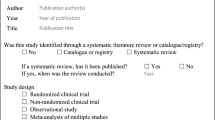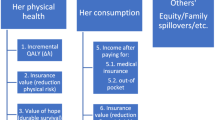Abstract
Objective: To explore whether the National Institute for Health and Clinical Excellence (NICE) takes account of concerns other than just incremental cost effectiveness in commissioning healthcare services.
Method: A stated preference binary choice experiment was used to explore the preferences of members of NICE’s Appraisal Committees for incremental cost effectiveness, the degree of uncertainty surrounding incremental costs and health outcomes, the age of beneficiaries, baseline health-related quality of life (HR-QOL) and the availability of alternative therapies when considering whether to recommend health technologies.
Results: A logit modelling analysis of Committee members’ stated preferences suggested that increases in the incremental cost-effectiveness ratio and economic uncertainty, and the availability of other therapies was associated with statistically significant reductions in the odds of a positive recommendation (p < 0.01). The transition from a very low to a comparatively high level of baseline HR-QOL was also associated with a statistically significant reduction in the odds of a positive recommendation (p = 0.003). The age of beneficiaries did not significantly affect decisions concerning whether to recommend technologies.
Conclusion: The results of the choice experiment support the notion of a probabilistic adoption/rejection approach rather than the operation of a single cost-effectiveness threshold.




Similar content being viewed by others
References
The National Institute for Health and Clinical Excellence. A guide to NICE. London: NICE, 2004: 1–34
Claxton K, Sculpher M, Drummond M. A rational framework for decision making by the National Institute for Clinical Excellence (NICE). Lancet 2002; 360: 711–715
Smith R. The failings of NICE. BMJ 2006; 321: 1363–1364
Rawlins MD, Culyer AJ. National Institute for Clinical Excellence and its value judgements. BMJ 2004; 329: 224–227
Rawlins MD. Scientific and social value judgements. London: NICE, 2004: 1–20
National Institute for Health and Clinical Excellence. Social value judgements: principles for the development of NICE guidance. London: NICE, 2005: 1–37
National Institute for Clinical Excellence. Supplementary evidence to the House of Commons Health Select Committee: Paper 2. London: NICE, 2002: 1–9
Devlin N, Parkin D, Gold M. WHO evaluates NICE. BMJ 2003; 327: 1061–1062
National Institute for Health and Clinical Excellence. Guide to the methods for technology appraisal. London: NICE, 2004: 1–71
Littlejohns P. Does NICE have a threshold? A response. In: Towse A, Pritchard C, Devlin N. Cost-effectiveness thresholds. London: King’s Fund/Office for Health Economics, 2002: 31–37
Louviere J, Hensher D, Swait J. Stated choice methods: analysis and application. Cambridge: Cambridge University Press, 2000
Devlin N, Parkin D. Does NICE have a cost-effectiveness threshold and what other factors influence its decisions? A binary choice analysis. Health Econ 2004; 13: 437–452
Nord E. Cost-value analysis in health care: making sense out of QALYs. Cambridge: Cambridge University Press, 1999
Jonsen AR. Bentham in a box: technology assessment and health care allocation. Law Med Health Care 1986; 14: 172–174
Le Grand J. Equity, health and health care. Soc Justice Res 1987; 1 (257): 257–274
Dolan P, Olsen JA. Distributing health care: economic and ethical issues. New York: Oxford University Press, 2002
Bryan S, Williams I, McIver S. Seeing the NICE side of cost-effectiveness analysis: a qualitative investigation of the use of CEA in NICE technology appraisals. Health Econ 2007; 16: 179–193
Johnson FR, Backhouse M. Eliciting stated preferences for health-technology adoption criteria using paired comparisons and recommendation judgements. Value Health 2006; 9 (5): 303–311
Ratcliffe J, Bekker H, Dolan P. The relative importance attached to access, equity and cost-effectiveness by people and organisations providing health services. NICE annual conference and exhibition; 2006 Dec 6–7; Birmingham
Farrar S, Ryan M, Ross D, et al. Using discrete choice modelling in priority setting: an application to clinical service developments. Soc Sci Med 2000; 50: 63–75
Dolan P, Tsuchiya A, Brazier J, et al. Social QALY project: summary [online]. Available from URL: http://www.shef.ac.uk [Accessed 2005 May 23]
Acknowledgements
This study was undertaken without external funding. None of the authors have any conflicts of interest to declare. We thank Dr Carole Longson, Prof. David Barnett, Ms Emily Marschke, Prof. Andrew Stevens and Prof. Jeremy Wyatt at NICE for making this study possible. The study team would also like to thank all the members of NICE’s Appraisal Committees who kindly participated in the choice experiment. Finally, we would like to acknowledge the advice of Dr Stephen Walters from the HEDS Section within ScHARR.
P. Tappenden initiated the research. P. Tappenden, J. Brazier, J. Chilcott and J. Ratcliffe designed the study and the choice questionnaire. P. Tappenden collated all response data and undertook the statistical analysis. P. Tappenden will act as guarantor for the paper, accepts full responsibility for the conduct of the study, had access to the data and controlled the decision to publish.
Ethical approval for this study was obtained from the Sheffield University Research Ethics Committee (UREC). Permission to distribute the choice questionnaire was kindly granted by Prof. David Barnett (Chair of Appraisal Committee, NICE, London), Prof. Andrew Stevens (Chair of Appraisal Committee, NICE, London) and Dr Carole Longson (Appraisals Programme Director, NICE, London).
Author information
Authors and Affiliations
Corresponding author
Rights and permissions
About this article
Cite this article
Tappenden, P., Brazier, J., Ratcliffe, J. et al. A Stated Preference Binary Choice Experiment to Explore NICE Decision Making. Pharmacoeconomics 25, 685–693 (2007). https://doi.org/10.2165/00019053-200725080-00006
Published:
Issue Date:
DOI: https://doi.org/10.2165/00019053-200725080-00006




